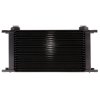Howard Jones
Supporter
Assume that the oil cooler is like the one pictured below. Oil flow comes in either the port on the left or the port on the right. Let's pic the left port. In to L port then to the bottom on the cooler left side and at the same time across from left to right, then out of the R port. If you pick the right side to use as an inlet then the flow is reversed. It does not matter which way it flows but it always flows across the cooler tubes. If the cooler is mounted so the ports are on the bottom then flow is exactly the same. At no time is the flow from top to bottom. Air cannot be trapped in the cooler because the oil is forced through the cooler from port to port.
Now as far as how to mount it, ports up or ports down. First, if the placement is dictated by hose routing that question is answered. However, if it can be mounted either way then the question is do you want to retain oil in the cooler when the pump is not pressurizing the system? The advantage of keeping the cooler full (ports up) is that the pump does not need to fill it before fully pressuring the system. It will retain oil during oil changes but it can be drained if necessary by removing the hoses and blowing it out with air pressure into a container. Just a few psi or you will have a big mess.
I think that the operational advantage of pre-charging the oil system by keeping the oil cooler full outweighs the ease of maintaining the oil system. After all the oil system is there to oil the engine not make it easy to change. This is a very similar concept to hanging the oil filter so it holds oil and not the other way around with the inlet and outlet facing downward and draining when the pump is off.
This is your answer I think. Fill the oil filter and cooler before the first turnover. Then crank the engine so it will fill the hoses and prime the oil system without starting the engine (ignition off). There are relatively low loads on the bearings until the engine starts. All there is, is cylinder compression load and valve spring loads. I wouldn't pull the spark plugs if it is really a lot of additional work.
On a brand new engine: I think this is where priming using an externally forced oil supply is a very good idea. Critical really. This can be done by attaching a pressurized oil supply onto a temporary "t" flitting in a cooler line and forcing oil through the entire system until you see oil pressure on the gauge. This is essentially how an accusump system works. You could add the last few quarts that the accusump contains to top off the engine oil fill. That would be my recommendation.
Now as far as how to mount it, ports up or ports down. First, if the placement is dictated by hose routing that question is answered. However, if it can be mounted either way then the question is do you want to retain oil in the cooler when the pump is not pressurizing the system? The advantage of keeping the cooler full (ports up) is that the pump does not need to fill it before fully pressuring the system. It will retain oil during oil changes but it can be drained if necessary by removing the hoses and blowing it out with air pressure into a container. Just a few psi or you will have a big mess.
I think that the operational advantage of pre-charging the oil system by keeping the oil cooler full outweighs the ease of maintaining the oil system. After all the oil system is there to oil the engine not make it easy to change. This is a very similar concept to hanging the oil filter so it holds oil and not the other way around with the inlet and outlet facing downward and draining when the pump is off.
This is your answer I think. Fill the oil filter and cooler before the first turnover. Then crank the engine so it will fill the hoses and prime the oil system without starting the engine (ignition off). There are relatively low loads on the bearings until the engine starts. All there is, is cylinder compression load and valve spring loads. I wouldn't pull the spark plugs if it is really a lot of additional work.
On a brand new engine: I think this is where priming using an externally forced oil supply is a very good idea. Critical really. This can be done by attaching a pressurized oil supply onto a temporary "t" flitting in a cooler line and forcing oil through the entire system until you see oil pressure on the gauge. This is essentially how an accusump system works. You could add the last few quarts that the accusump contains to top off the engine oil fill. That would be my recommendation.
Attachments
Last edited:


